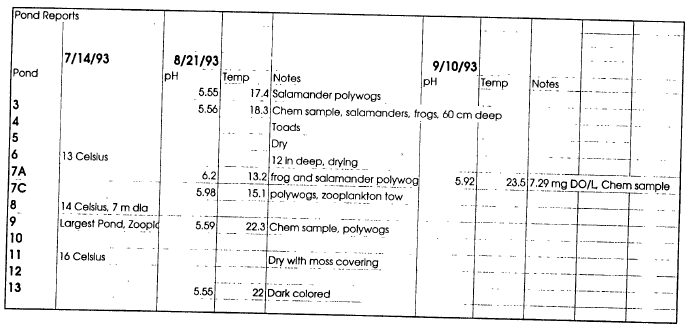Crater Lake National Park Whitehorse Pond Limnological and Vascular Plant Study, 1993
3.0 RESULTS
3.1 Physical Characteristics
The ponds were found to be full of water and teeming with life early in the summer season. However, later in this wet year all except two ponds were dry. The following describes the several field days
July 5, 1993, First Trip
The first attempt to visit the ponds was not successful. Beginning on the Pacific Crest Trail, the author and his son, Garrett, walked west and were lead over a series of hilltops and valleys. The ponds were actually farther south and west than the map suggested. This first trip on July 5th did not produce any samples or observations of the ponds directly.
July 14, 1993, Second Trip
The second trip to the ponds was on July 14. Scott Swarts of the Crater Lake stream survey team accompanied the author to Whitehorse Bluff. On this field trip we climbed the bluff on the north side and arrived at Pond #7 first. Few observations were taken there in hopes of finding larger ponds. Pond #6 was encountered next and its temperature at 1700 hours was 130 C (Table 1). Pond #8 was encountered next and was determined to be about 7 meters in diameter, grass covered the bottom, and it was 140 C. In addition there were mosquito larvae and water bugs in the water. It was a foot lower than full on this date.
Walking west we arrived at one of the largest ponds on this date, Pond #9. We called it Frog Pond as it is referred to in Bob Truitt’s report. We collected two zooplankton samples. The first at 1800 hours on the north side of Pond 9A and the second tow at 1825 hours was collected on the south side of Pond 9A. The tows were made by holding the 12 cm diameter net at surface level as the other walked a semicircle with the cord to a spot on the other side of the pond. The net was pulled through undisturbed water about 50 cm deep and 10 cm off the bottom. Any shrimp collected were trapped in the vertical portion of the tow which occurred at the end of the horizontal tow.
|
Table 1. Physical Data From Selected Whitehouse Ponds. |
Frog tadpoles were noticed and were about one inch in length. Also noticed was a campfire ring on the southeast side of Pond #9A.
Turning south we encountered Ponds #10 and #11. Pond #11 was 160 C and was down from full by about 30 cm. Pond #12 was found by walking further south and was covered with a grass bottom.
The final pond group observed on July 14th was east of Ponds #10, 11, and 12. There is no number for this group but we identified it by a tree striped of its bark by a bear. We called it Bear Tree Pond. A single small pond was found north of a larger pond complex. Moss covered the southern side of the smaller pond. Salamander egg masses covered the north side of the larger pond. An adult frog was photographed in the larger pond. Two zooplankton tows were made at 1900 and 1920 hours in the larger pond.


